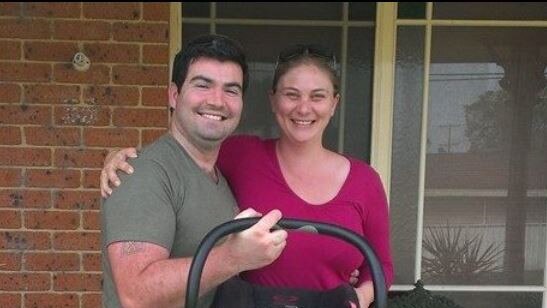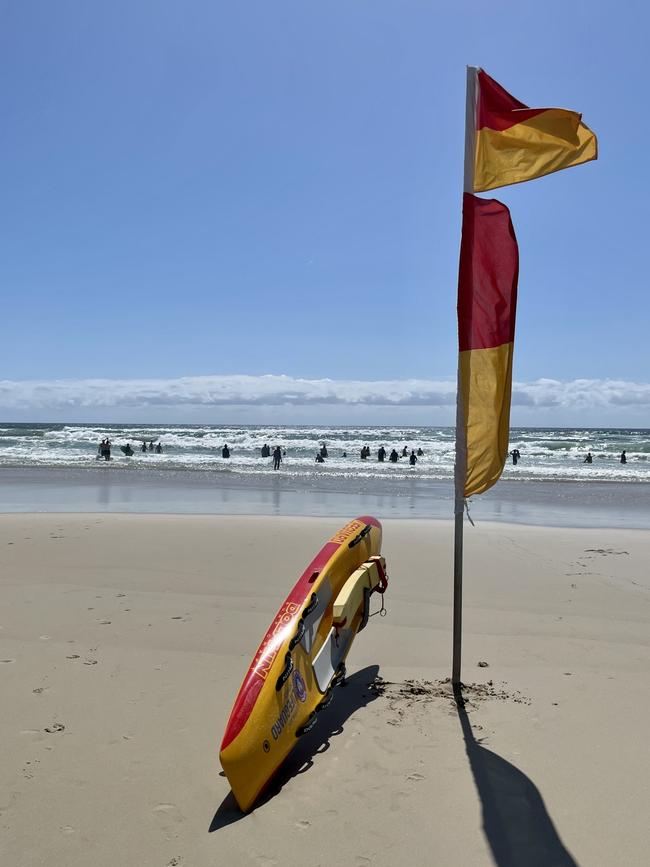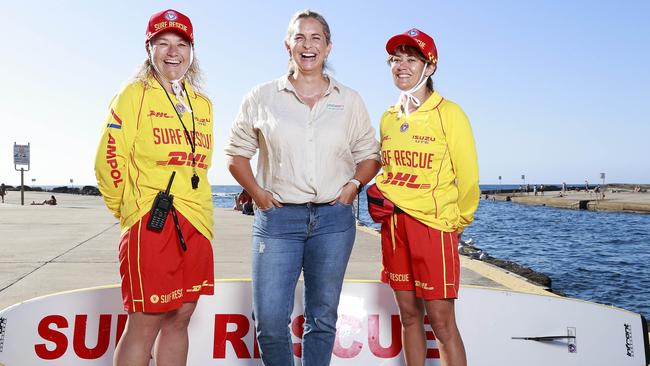Record drownings: 28 lives lost in NSW over 90 days of summer
A horror summer on NSW waterways has seen a record 28 people drown, forcing authorities to rethink how to keep swimmers safe at unpatrolled beaches.
NSW
Don't miss out on the headlines from NSW. Followed categories will be added to My News.
For Simonne Doran, it’s some comfort that her husband Paul “died a good death” saving his family, but says it does little to lessen the enormous pain of his loss.
The 45-year-old, who emigrated to Australia from Ireland last July with his wife and three children, Vann, Lyra and Shay, was one of 28 people to drown in waters off the NSW coastline this summer — the highest number ever recorded.
The Dorans and their children were only in shallow water at Seven Mile Beach, Lennox Head, when their 11-year-old daughter was swept out to sea on a bodyboard around 6.30pm on January 18.
Paul swam out, his wife did too. His heroic efforts to save them cost him his life.
“He was as deep and indomitable as the ocean that claimed his life,” Simonne shared on an online fundraising page the day after his funeral service last month.
“He died a good death saving us, and that’s some comfort. But does little to lessen the enormous pain and emptiness of his loss.”
Family, friends, even strangers have rallied around the family, raising more than $110,000 to help them as they cope with the tragedy many miles from their family back in Ireland. For that, his wife is immensely grateful.

“We were so happy with our life in Australia. It took so much to get here, it was so stressful. But we did it together. Paul was the driver, but together we made it happen. We felt that life was great,” Simonne wrote.
“Paul was the happiest I had ever seen him once we had settled into our life in Lennox. He had even started wearing flip flops and shorts — and for anyone that knows him this was so outside his comfort zone.
“Losing Paul has been a tremendous blow to our whole family. He still had so much to live for, so much to do, so much to give.
“Our children feel his absence immensely. But I think he will always be with us.”

The community has also rallied for the family of Matthew Mulhall, 45, who died on February 8 trying to rescue his wife Kathryn Singleton on Frazer Beach on the state’s Central Coast.
The pair died, orphaning three children, including their five-year-old daughter Amelia, who has autism and who was watching on from the shore.
More than $45,000 has been raised for them so far.
Others have died this summer, trying to save others.
NSW veteran police officer Sergeant Peter Stone, 45, died on New Year’s Day saving his 14-year-old son from a rip at Bogola Beach, near Narooma.
Father-of-six Talitiga Taupau — the uncle of NRL star Marty Taupau — died at Cronulla’s Shelly Beach on January 28 while trying to save two others who had been caught in the same dangerous current.
Brent Manieri, operations manager for public safety for Surf Life Saving NSW (SLSNSW), says “bystander” deaths had been a feature of the horror summer of drownings, spurring authorities to add to their safety messaging and think differently about how they can better resources unpatrolled beaches with safety equipment.
“We’ve seen five bystander rescuers lose their lives this summer, and in each of these cases the rescuer didn’t have a flotation device with them,” he said.
“So we’re pushing the message that if you’re going to an unpatrolled location, ensure you have a flotation device with you to assist both you and the person you’re attempting to rescue.
“You may not want to go for a surf, but having a surf or bodyboard handy may save your life, or that of your family member or friend.
“SLSNSW, too, is focused on boosting the provision of public rescue equipment at beaches.
There’s already angel rings and rescue tube boxes positioned along stretches of the coastline and we’d like to add to these. However that requires people to be proactively monitoring these to ensure the rescue devices are available when they’re needed the most.”

Surf Life Saving Australia this week released the national 2022/2023 summer coastal drowning statistics — and they’re chilling.
In 90 days — from December 1, 2022 to February 28, 2023 — there were more than 6000 rescues performed along Australia’s coastline and 54 drowning deaths, more than half of those in NSW. That was 14 per cent above the 10-year average.
More than 40 per cent of the deaths were due to rip currents, a 70 per cent increase on the 10-year average. Rip currents remain the number one coastal hazard, with around 17,000 rip currents across the country on any given day.
Men continue to be over-represented in drowning figures, accounting for four out of five deaths.
With the warm weather continuing, authorities are concerned there’s more to come.
On Friday morning, a search resumed for a 30-year-old man who was seen struggling in the surf about 30m offshore of Main Beach in Byron Bay about 5.30pm on Wednesday.
Mr Manieri said with 100 per cent of the summer’s coastal drowning deaths occurring either at an unpatrolled area, outside patrol hours, or outside the red and yellow flags, authorities were looking at a range of other ways to keep people safe.
Traditional messaging to “stay between the flags” and visit patrolled beaches is only applicable at the state’s 129 patrolled beaches — there are several hundred more which are unpatrolled.
“We’ve had as bad a summer as I can recall, with the most drownings along the NSW coastline that we’ve ever seen,” Mr Manieri said.
“These are occurring at unpatrolled locations, outside the red and yellow flags, so we need the community to take heed of the messaging, to work with us to try and drive down that figure.
“SLSNSW is working with a wide range of landholders and managers on how to roll out a multifaceted approach so we can cover more of the coastline.
“We can’t have active patrols at every beach, but we are increasingly surveying known black spots remotely, and aiming to get emergency response beacons at more of those locations so members of the public can make contact with us, and we can take control of the cameras on those beacons to get more situational awareness of what is happening and provide advice while calling in backup.

“While we can’t put the red and yellow flags up at every beach, we can have roaming patrols such as rescue jet skis in the area and able to respond quickly. These are just some of the ways we are working to better cover the large swathes of coastline.”
Olympic swimmer Libby Trickett knows only too well the risks around water — at the beach, in the backyard and any waterway — after her young daughter, now two, slipped quickly and silently into their swimming pool around 12 months ago.
“It’s so easy to get distracted. My youngest daughter was near the pool, my husband who was around a metre away took his eyes off her for seconds to attend to our other daughter and Bronte slipped into the water,” she said.
“She would have been under water for 20 to 30 seconds, he didn’t hear her fall off the step and in the water, but she managed to get her little face up and gasp and he heard that.
“It could have been many more seconds before he turned round.
“It’s just that moment of distraction, that’s all it takes.”
Since then the couple — who were already water conscious — have made even more effort to watch their children around water, ensuring one of them is the designated supervisor and taking other safety measures.
“It really reminded us that water safety is everyone’s responsibility — everywhere,” she said. “At the beach you see parents and groups out enjoying themselves. At patrolled beaches they have that sense of safety, but even where there are lifesavers, you still need to watch your children, your friends and family.
“We have a beautiful coastline that’s there for everyone to enjoy, but you have to be vigilant so that a fun day at the beach is also a safe one.”

The seven-time Olympic medallist is also an ambassador for PoolWerx, with a mission to bring down the number of preventable child drownings in Australia.
Mr Manieri also encouraged people to be proactive when heading to enjoy the water.
“People are enjoying the warmer weather after colder, wetter summers; they’re enjoying the freedom after pandemic lockdowns and restrictions, but it also means they’re going to the beach more and venturing further, so they’re often ending up at beaches they’re not familiar with,” he said.
“I’d encourage everyone on arrival at a beach to take time to observe the conditions, look for rips and other potential hazards. To understand what the conditions are and recognise whether they have the skill and experience to go into the water. Ensure you’re with someone else to call for help if needed, again take a flotation device.
“If you do get into trouble, try to relax and float and signal for assistance. The less energy you use up, the more time lifesavers will have to get on scene and assist you.”
Adults who were not confident in the surf, or who had missed out on swimming lessons when young, should not feel embarrassed to attend lessons to strengthen their swimming, Mr Manieri said, because far too many Australians — and visitors — did not have sufficient skills in the water to deal with the conditions.
Mr Manieri also praised lifesavers and lifeguards for the thousands of lives they had saved this season.
“The amount of work they have undertaken to make sure there has been no more fatalities is immeasurable,” he said.
“Over 6000 rescues, and in excess of 300,000 preventative actions at beaches across NSW.”
Got a news tip? Email lisa.wachsmuth@news.com.au




